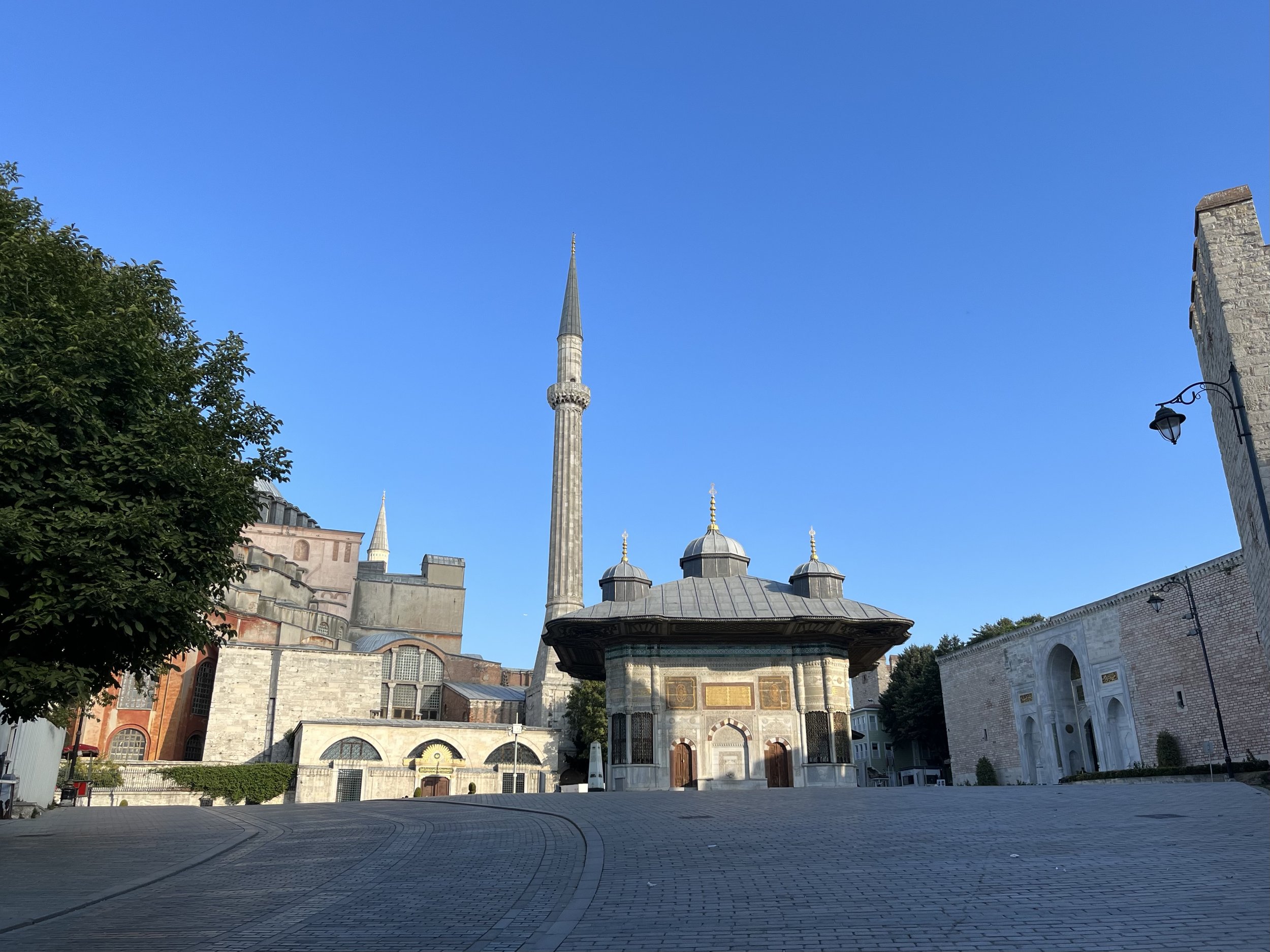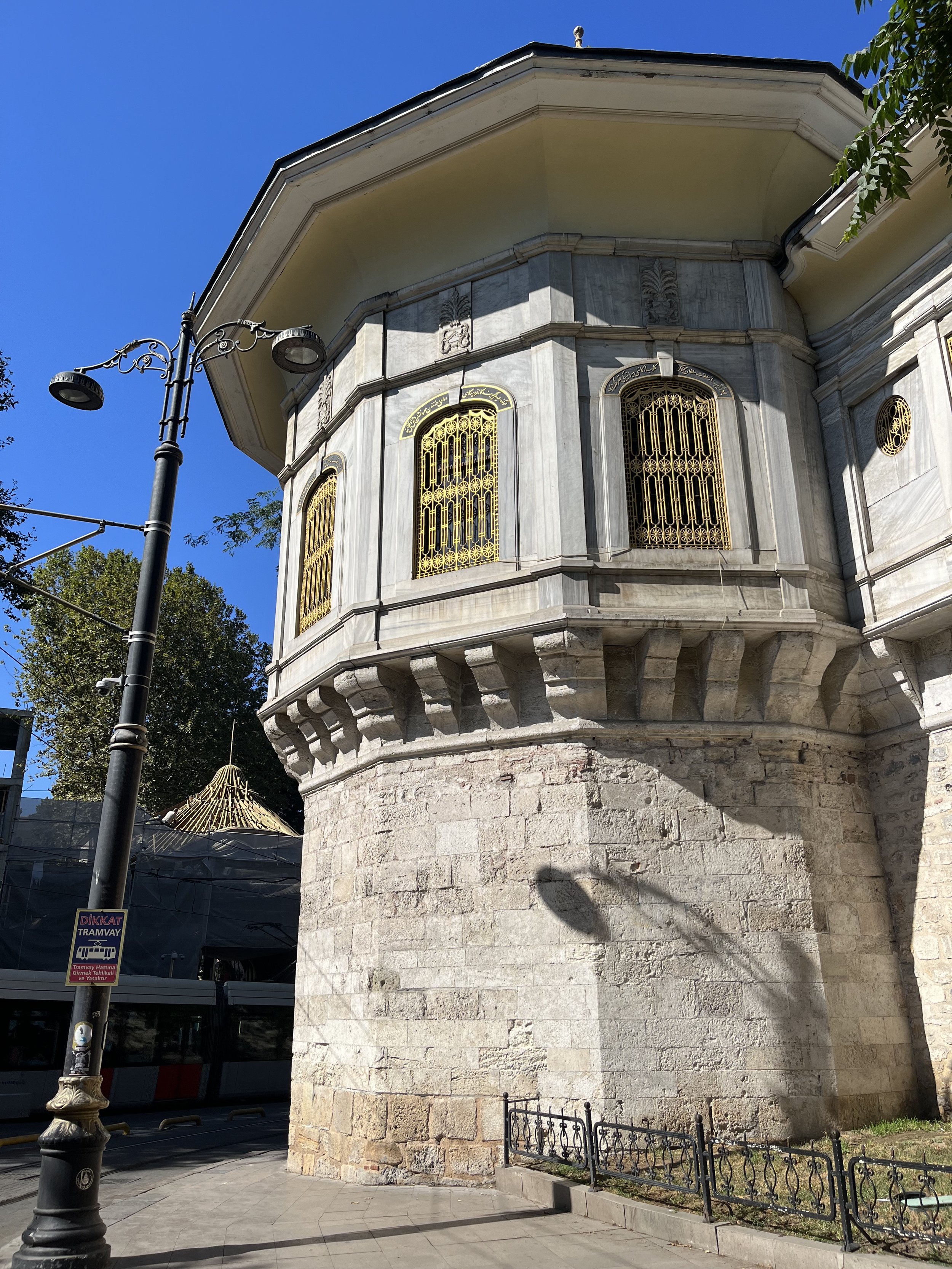Vacation Part 3- Full Circle
The Cold Fountain outside the main gate of the Topkapi Palace. Hagia Sofia in the background to the left.
Our third day of vacation started shortly after sunrise with a visit to the imperial residence at the Topkapi Palace. Our guide book suggested being there at opening time to avoid the inevitable crowds, so immediately after breakfast we made the short walk to the end of the street and up the hill to the gate. Unknown to us at the time, the Palace is closed on Tuesdays, so we stood around for a while waiting for something to happen until an employee reporting to work broke the news. Fortunately, our next stop was a short walk away and wasn’t open yet. We managed to beat the crowds at the Hagia Sofia.
A quick note on the spelling of names. Many languages don’t have a “universal” English language translation convention. Arabic and Turkish are among the least standardized. For example, how many ways are they to spell Mohammed in English? So, don’t panic when you see different names and spellings for the same thing. In the case of this particular structure, Hagia Sophia is also the Aya Sofya, or Ayasofya .
The sign on the north face of the building identified this as the Madrasah of the Ayasofya. Basically the religious school of the Hagia Sophia Mosque.
The view from the queue. We learned that the building will undergo a roof repair and major restoration next year. Don’t be surprised if it isn’t open if you visit sometime in next fifty years.
So what is the Hagia Sophia? Commissioned by Constantine, the Christian Emperor of Rome, the building started life as a Basilica in 360AD. Unfortunately, it burned in 404AD. The replacement was completed in 415AD, and then burned down again in 532AD. The current building was completed in 537AD. It served the Orthodox Christians of the Byzantine Empire until that fateful year of 1453, when the conquering Ottomans converted it to a Mosque. It stayed that way until 1935 when the Republic of Turkey decided to operate it as a museum. That lasted until 2020, when President Erdogan decided it should be a mosque once more.
Our tour guide said to us, “Image if your President Biden just decided one day that a museum should be a church or mosque, or vice versa? You Americans would go crazy!” The guy had a point.
We were very fortunate to see the sanctuary before the crowds arrived.
Just a few minutes later, the place was full.
Part of the conversion to a mosque included covering the depictions of human beings. When the building was operated as a museum, some of the faces were uncovered. At the front of the sanctuary, the depictions of Jesus and Mary are obscured by white drapes.
The next stop on our tour of the Istanbul’s antiquities took us across the street to the Basilica Cistern. If you’ve seen the James Bond films “From Russia with Love” or “Skyfall,” you’ve seen it. It is also in the Tom Hanks film “Inferno.” It’s as cool as it looks in the movies and a great place to duck under the busy city. Built in 542AD, it was meant to supply water to the Grand Palace of the Byzantine Emperors. It later supplied water to the gardens of the Topkapi Palace. It measures 140 by 70 meters. There are 336 columns holding up the brick roof. The columns were collected from other structures, consequently they are all different. Archeologists think there may be other similar cisterns undiscovered in the old city.
The light color and brightness is constantly changing to enhance the view.
Water stains on the columns indicate the various water levels in the past.
So, what do two pedestrian tourists do next after taking in a couple really cool sights? Find more!
After returning to the bright light of day, we hoofed our way to the west, eventually entering the commercial district of the old city. The center of that little piece of mayhem is the Grand Bazaar. There is over 30,000 square meters of retail space under a roof that dates back to 1455AD. The official records claim 6600 shops, 50 cafes, 11 warehouses, and 18 fountains. There is also a post office and police station, 13 mosques and a cemetery.
We walked through from one side to the other and were completely overwhelmed. It also made a showing the the Bond film “Skyfall” with a chase scene on the roof.
Shopping malls have nothing on this place.
There is no rhyme or reason to the physical layout of the Grand Bazaar. You just have to jump in.
As neat as the Grand Bazaar was, the next place we visited came in close to the top of out list of favorite places. Exiting the west side of the big bazaar, we wandered north along a narrow street that divided the shopping area from the University of Istanbul. On the left was tall wall with a small gate that led into the Book Bazaar. Wedged between the wall and Beyazu Mosque, it was like walking into a little slice of book worm heaven. The noise of mass commerce was left behind and replaced with book sellers chatting with customers. We browsed the offerings in a wide array of languages and then took a water break on a bench. In the relative peace and quiet, we watched a young cat playing in an empty box before moving on to our next destination.
Heading north, our destination was the Spice Bazaar near the Galata Bridge of the Golden Horn. Our walk took us through shopping areas where everyday Turks shopped for housewares, shoes, men’s formal suites, and women’s clothing. The route was simple enough because it was all down hill. At the bottom of the hill, we wandered through a bazaar that sold about all the things you might expect in a Walmart. One stall had yard tools, which I though was an odd item to sell in the heart of the big city. After marveling at gigantic rice cookers, this segment of the day’s walk ended at a lunch place called Burgerillas.
Down hill through the “Home Appliance” section of town.
Part of the joy of traveling is interacting with the locals. Since The Captain and I have zero language skills applicable to Turkey, we were limited to folks who could converse in our tongue. At Burgerillas, that was our server Esmail. When he’s not in school for Marine Engineering, he commutes two hours a day to wait tables in a burger joint. He dreams of getting a third engineer billet on a merchant ship. While he’s sailing over the horizon, his brother Baki, working as the front man handing out menus for Burgerillas, aspires to owning his own restaurant. Good luck guys.
If you were wondering, the burger was good, but the fries were fantastic.
Part of the conversation with Esmail included his recommended sights to see in the city. At this point in our journey, we had about 24 hours left in the city, and we didn’t want to miss something important. He was adamant that we walk across the Galata Bridge and climb the hilltop Galata Tower. Taking his advice, we did just that, and had a very memorable journey.
Walking over the very busy connector between the old and new city was an experience not to be missed. The bridge is built in two levels. On the top is the roadway and two sets of tracks for the light rail trains zipping around the city. On the lower level, there are seafood restaurants, supplied by the fishing boats that unload nearby. To make it more fun, semi-pro rod and reel fishermen hang out on the upper deck, catching six inch long silver colored fish. Sorry, I don’t know what kind of critter it is, but I read they catch 60 tons of them each year.
Esmail claimed the best view in the city was from the Galata Tower. He was right. A military tower of some sort occupied the location as far back as 507AD. The current stone tower was originally built by the Genoese traders who occupied the neighborhood in the 1300s. It was damaged by an earthquake and rebuilt in 1509, and then used as a prison by Suleiman the Magnificent. It then became an astronomical observatory before reverting back to being a prison. (The Sultans were big on prisons.) Ironically, in 1717 it became a fire watch tower, and then burned in 1794 and 1831. Now it’s all about extracting $$$ from tourist in exchange for a little history and a cool breeze.
The Galata tower overlooking the double deck bascule draw bridge across the Golden Horn.
Looking back at the old city from the Galata Tower. It was about this time when we realized how far we had walked.
Looking north east across the Bosporus at the Asia side and the Camlica telecom tower.
The smaller cruise ship in the center of the picture was the next day’s destination.
Our original planning didn’t include a trip to the Tower, but we were glad we listened to Esmail. The only regret was the distance to be covered making our way back to the Byzantium Hotel. My GPS gizmo had us walking seven and a half miles to the Tower. The Captain plotted a route back on her phone and came up with a four mile down and up trek. So, we bought a couple bottles of water and head back down the hill.
The life lesson of the day came at the north end of the Galata Bridge. There is a light rail stop there and we thought we’d hop a ride up to the Hippodrome. Seemed easy enough, except we couldn’t figure out how to buy a one way ride to the desire stop. Our frustration was compounded by a guy following us around trying to sell us a ten ride pass for 170 L, which we knew we didn’t want. After asking around a bit, we finally found a couple of youngsters who spoke English much better than the street hustle guy. It turns out that the 170 L pass was the smallest purchase possible. For 340 L we could ride the remaining 3 miles to the top of the hill. I was annoyed at that point and said “Screw it. We’ll walk.”
Arriving at the other side of the bridge, we successfully negotiated our only visit to a pay restroom. (The mosques have free facilities.) It costs one Lirasi to use and the smallest denomination I had was a ten Lirasi note. The Turks think of everything when it comes to the money hustle and had a guy in a booth at the entrance making change. I swapped my tenner for ten quarter sized coins and we were in business. Of course, now I had eight coins jingling in my pocket for the rest trip. You know, just in case.
With the last of our pit stops complete, we began climbing back up the hill. The strategy at that point was staying in the shade because it was the hottest day Istanbul had all week and the wind didn’t quite make it to streets level. Finally, cresting the hill between the walls of the Topkapi Palace and the Hagia Sophia, we caught some breeze and and coasted back down to the hotel, clocking a full 12 miles of sightseeing.
For much of the walk, we followed the perimeter of the Topkapi Palace. At the northwest corner, we rounded the Alay Pavillion, where the Sultan could watch ceremonies and parades in his honor without having to leave the safety of the palace walls.
The Cold Fountain, where we started the day. It was warm enough that even the local dogs were seeking relief.



















